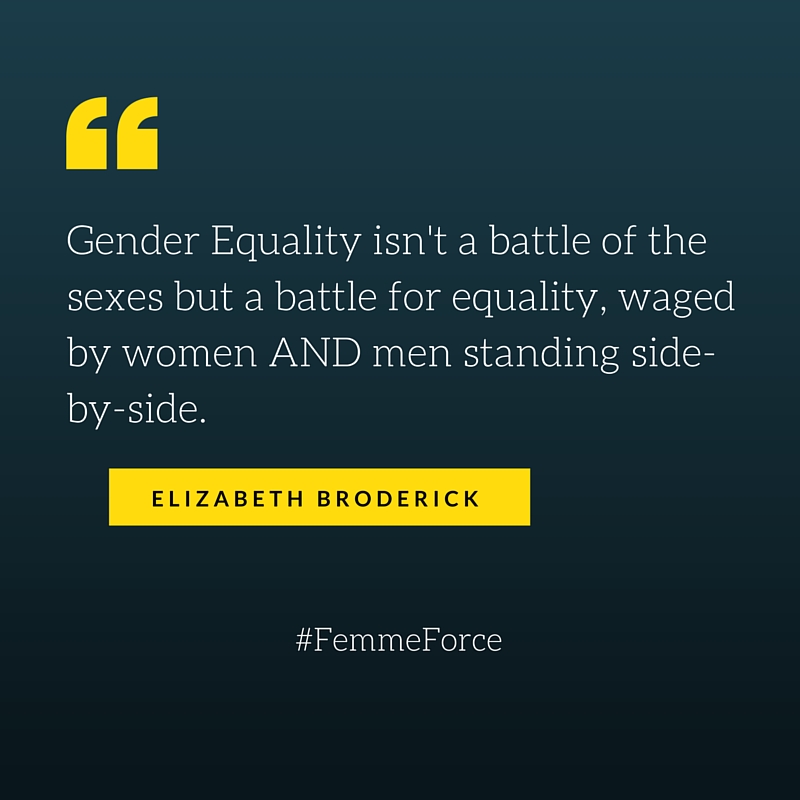
Get your FREE 30-day trial.
Start by selecting a product:
If what you are doing isn’t working, then you need to try something different. That’s why Sex Discrimination Commissioner Elizabeth Broderick mixed things up when she took up her position eight years ago:
"[Elizabeth Broderick] aimed to change the role of powerful men in this debate – to stop them being merely the hostile or defensive recipients of complaint and start them asking questions of themselves , like: "What does it cost my business to waste half of the leadership potential that exists in its junior ranks?."1
In 2010 Ms Broderick established a movement called “Male Champions of Change” which calls on male leaders to step up beside women and drive gender equality in their places of work.

At Salesforce we’ve included men in promoting workforce diversity right from the beginning, following the example of our founder Marc Benioff. 2 Nevertheless, one year in, we conducted a feedback survey locally across the company to see what progress we had made. The single biggest request was to hear more from the senior male leaders. So we asked them! Three senior male leaders joined me to discuss their views on gender diversity.

I want to thank Mark, Julian and Paul for being so honest, authentic and open. We discussed several topics including Unconscious Bias and Work-life balance, but the highlights for me were delivered in answering the 2 questions below:
1. What are the Barriers to Gender Parity - particularly in Senior Leadership?
All three agreed that there is a smaller pool of women in technology and those women do not have the same opportunities to build experience and often lose out to men when competing for senior roles. But that doesn’t mean women are any less capable. The panel agreed that companies needed to “take a punt” on women - even if they perhaps weren’t the most experienced candidate - in order to correct the imbalance. Paul, Mark and Julian all thought that more effort should be made to mentor, develop and promote women. Paul probably summed it up best when he addressed what is probably commonly known as “the boys’ club”:
“When people are under pressure to get results, they tend to look to people like themselves which has perpetuated the problem over time. We need to provide mentorship and guidance [for women] because you’ll never get that first opportunity if you haven’t had the experience. You need someone who is prepared to stand behind you and push you forward. ” Paul Voges
They made the important point that companies need to try harder to help women returning to the workforce after having a family - Paul said that he had seen female equivalents end up two years behind him in career progression and this was not fair.
While targets is a controversial topic, the panel agreed that they were essential to progress:
“If we are going to increase the numbers of women in senior leadership positions, and I think we should, then we should make a conscious decision on that basis...otherwise we will never feed that pool because they will never get there.” Mark Innes
2. What progress have you made to address this Gender Imbalance?
Each of the leaders talked about the progress they have been making. It is inspiring to see how they have prioritised this issue. Julian was able to report that in his organisation they have increased the female/male ratio over the past 12 months. “There is still work to do but moving absolutely in the right direction with very clear KPIs to drive it.”
At Salesforce we are seeing real change taking place, driven by our senior male leaders. Here are some of the exciting initiatives the leaders on the panel are putting in place
Targeting a 50/50 gender mix
Analysing and addressing salary imbalance between genders
Mentoring and sponsoring of high potential females
Lowering the barriers to entry for women to ensure equality of opportunity
Equal representation of women in the hiring process to shift unconscious bias
Supporting flexible working arrangements for females
"Anything that requires transformation - including gender diversity - requires the CEO to be in the middle of it." Marc Benioff
Organisational transformation needs to be driven from the top-down. It is an absolute must to have your CEO/Leadership team not only bought in, but driving it, monitoring progress closely and rewarding success. According to Liz Broderick, there are “fewer Big Australian companies run by women than by men named Peter,” it is likely that for the time being at least... your CEO is a man .
Sources: